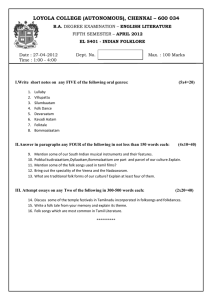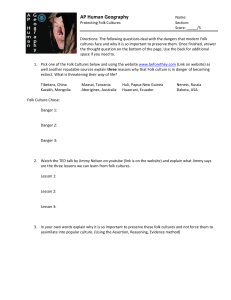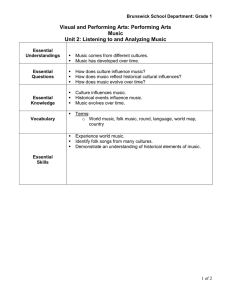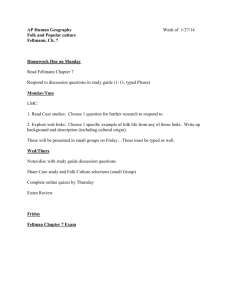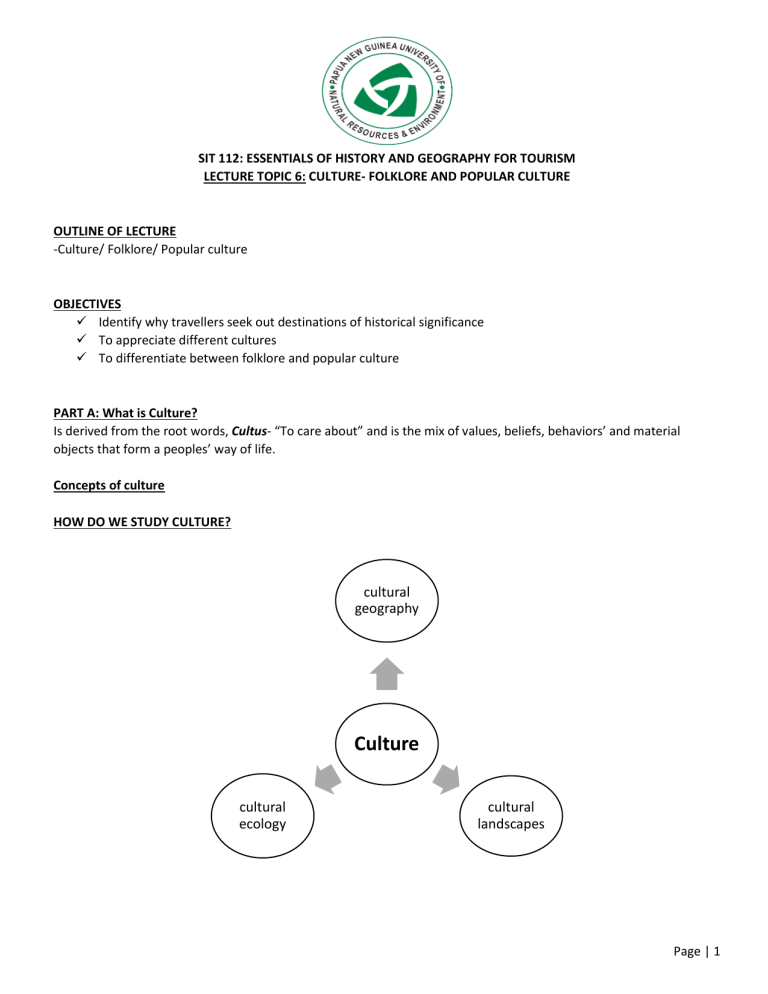
SIT 112: ESSENTIALS OF HISTORY AND GEOGRAPHY FOR TOURISM LECTURE TOPIC 6: CULTURE- FOLKLORE AND POPULAR CULTURE OUTLINE OF LECTURE -Culture/ Folklore/ Popular culture OBJECTIVES Identify why travellers seek out destinations of historical significance To appreciate different cultures To differentiate between folklore and popular culture PART A: What is Culture? Is derived from the root words, Cultus- “To care about” and is the mix of values, beliefs, behaviors’ and material objects that form a peoples’ way of life. Concepts of culture HOW DO WE STUDY CULTURE? cultural geography Culture cultural ecology cultural landscapes Page | 1 CONCEPT OF CULTURE How does culture form? A repetitive act that an individual performs Habit Custom A repetitive act of a group performed so that it becomes a characteristics of the group culture A group’s entire collection of customs What is culture made of? Material culture (artefacts)- House, furniture, instruments, books Non- material culture- values, beliefs, behavior and norms. How do people adapt to culture? Through Acculturation- is the process of the less dominant culture adopting the traits of the more dominant one. Assimilation- is when immigrants lose their native customs completely. How do we interpret culture? Ethnocentrism- The practice of judging another culture by the standards of one’s own culture Source: www. Slideshare.net Page | 2 Cultural relativism is the practice of evaluating a culture by its own standards. Source: www. Slideshare.net Introduction to Folk and Popular culture FOLK CULTURE The term folk tends to evoke images of what we perceive to be traditional costumes, dances, and music. It seems that anything with the prefix folk refers to something that somehow belongs in the past and that is relegated to festivals and museums. The word folk can be traced back to Old Norse/English/Germanic and was used to refer to an army, a clan, or a group of people. Using this historic information, folk culture (folktales, folklore, etc.) can be understood as something that is shared first among a group of people and then with the more general population. It is a form of identification. Folk is ultimately tied to an original landscape/geographic location as well. Folk cultures are found in small, homogeneous groups. Because of this, folk culture is stable through time, but highly variable across space. Folk customs originate in the distant past and change slowly over time. Folk cultures move across space by relocation diffusion, as groups move they bring their cultural items, as well as their ideas with them. Folk culture is transmitted or diffused in person. Knowledge is transmitted either by speaking to others, or through participating in an activity until it has been mastered. Cooking food is taught by helping others until an individual is ready to start cooking. Building a house is learned through participating in the construction of houses. In all cases, folk cultures must learn to use the resources that are locally available. Over time folk cultures learn functional ways to meet daily needs as well as satisfy desires for meaning and entertainment. Folk cultures produce distinctive ways to address problems. Houses tend to be similar within a culture area, since once a functional house type is developed, there is little incentive to experiment with something that may not work. Food must be grown or gathered locally. People prefer variety, so they produce many crops, plus relying on only a few foods is dangerous. Clothing is made from local wool, flax, hides, or other materials immediately available. Local plants serve as the basis of folk medicinal systems. People are entertained by music that reinforces folk beliefs and mythologies, as well as reflects daily life. Folktales or folklore exists as foundational myths, origin stories or cautionary tales. Holidays provide another form of entertainment. Special days break the monotony of daily life. A holiday such as Mardi Gras, which has its roots in the Catholic calendar provides an occasion to flout cultural norms and relieve tension. Another way of providing escape from monotony is provided by intoxicants. Although often not considered when discussing culture, human beings have been altering their own mental states for millennia. The production of alcohol, cannabis, tobacco or coca demonstrates that folk cultures understood the properties of psychoactive substances. Later these substances would be commercialized into modern products. As folk cultures have receded there has been a return to valuing the folk. The Slow-food movement and the growth of cultural tourism has largely been driven for the desire experience elements of folk culture. As early as the German Grimm Brothers (19th Century Germany) people have wanted to preserve and promote Page | 3 folk culture. John Lomax (1867-1948) traveled the United States trying to record as many folk songs and folk tales (including slave narratives) as they faded from human memory. Folk culture can also be expressed as craftsmanship versus factory work. Hand production of goods requires a great amount of knowledge to select materials, fabricate components, assemble and finish a product. Contrast this with industrial production in workers need to know very little about the final product, and have little relationship with it. This difference in modes of production was first discussed by Ferdinand Tönnies and Gemeinschaft and Gesellschaft. These two words denote the relationship between people and their communities, and by extension, their landscapes. Gesellschaft is the way life is lived in a small community. Gemeinschaft is the way that life is lived in a larger society. TRAITS OF FOLK CULTURE usually relatively isolated Are often isolated or have multiple hearths often dependent on the environment Folk culture Anonymous hearths, anonymous dates usually practised by small, homogenous groups in isolated areas Folk culture can be expressed in three (3) ways; Indigenous Cultures A culture group that constitutes the original inhabitants of a territory, distinct from the dominant national culture which is often derived from the colonial occupation. Folk Culture Regions Cultural norms traditionally practiced by a small, homogenous, rural group living in relative isolation from other groups Subcultures Groups that share in some parts of the dominant culture but have their own distinctive values, norms, language and/ or material culture Page | 4 THE CHANGING CULTURAL LANDSCAPE It is understood that folk culture has been declining in the face of popular culture for some time. What is driving this decline? There are many things, with different underlying processes. Politically, in the last few centuries many places have been incorporated into states. These states have often pursued nationalistic policies that made life difficult for minorities of nearly every variety. The growth of a state-sanctioned national culture is the beginning of popular culture. Something as innocuous as public schooling or an official language can serve as a vehicle for promoting national values. Even if there is some overlap between the old culture and the new, the old has been prised loose from its central position in communal life. Economics also plays a role. Small, rural communities have been shrinking globally for centuries, since the beginning of the Industrial revolution. Leaving the spatial confines of a folk culture makes reproducing that culture very difficult, due to its close connection to place. When people migrate to places practicing popular cultures, the pressure to acculturate and assimilate are tremendous. Changes in infrastructure has also aided the diffusion of popular culture. Roads bring in outside people, as well as reduce the friction of leaving a place. The internet has dramatically reduced the friction of distance regarding the diffusion of popular culture. It took decades for tomatoes to diffuse from the Americas to Italy, but we know about a new iPhone months before it even gets released. The United States is huge laboratory of cultural interchange. Innumerable distinctive folk cultures were already in the Americas when the Europeans arrived. Waves of people from folk cultures arrived for decades, and they changed the larger culture of the United States. Places of folk culture aren’t the only places that are changing. Many places with an established popular culture are subject to interaction between different pop culture spheres. At one time immigrants to the United States came from folk cultures. Now they are often from areas of popular culture. The Spanish-speaking world has its own pop music stars, and chart-topping musicians from different countries will often collaborate together garnering airplay and sales around the world. World regional cuisines are subject to becoming fads as well. POPULAR CULTURE Popular culture is culture that is bought. Think about your daily life. You work to buy food and clothing, pay your rent, and entertain yourself. The origin of each ingredient in your food could be hundreds or even thousands of miles in either direction. Your clothing almost certainly wasn’t made locally, or even in this country. Your house might look just like any house in any subdivision in North America, placeless and with little connection to local resources. Popular culture is driven by marketing. Entire industries exist to convince us that our desires and needs will be best met through shopping. Why is this? Because without sales, the companies that produce pop culture will go bankrupt. Popular culture industries must continuously reinvent themselves. Being popular today is not a guarantee of longevity. In order to convince consumers that last year’s t-shirt is now unacceptable, it is necessary to promote fashion. Fashion is not just a concept related to clothing. It is the reason that automobile companies make cosmetic changes to their products every year. It is why fast food restaurants continually change some parts of their menus. Without the cachet of fashion, consumers may feel socially disadvantaged. This explains why some people with very limited incomes will spend money on expensive luxuries. In terms of popular culture holidays are simply reasons to sell merchandise. The commercialization of Christmas has been increasing for over a century in western countries. Now it is possible to see Christmas displays in Japan or China, places with few Christians, but many available consumers. The same sort of marketing can be seen in the expansion of Halloween globally, and in the growth of Cinco de Mayo in the United States. Hierarchical diffusion plays prominently in popular culture diffusion. Larger places tend to generate many of pop culture’s hit songs, clothing styles, and food trends. Diffusion in popular culture is highly related to technology. Page | 5 Although it wasn’t invented as such, the internet has become a venue for advertisement. Clickbait headlines and ad revenue have created an atmosphere where every conversation is a sales pitch. This hierarchical diffusion means that innovations tend to diffuse from large, well-connected places to other large-well-connected places first, then trickledown to smaller and smaller places. The gap in time that it takes for a new idea or product is known as cultural lag. In some places, there is almost no cultural lag. To very remote places, some innovations take a very long time to arrive. Bear in mind that there are places in the United states that still have no internet service. Popular culture covers large populations with access to similar goods and services, but the pressing need to sell drives almost incessant modification, generally at a superficial level. Because of this we usually describe pop culture as stable across space, but highly variable across time. The commodification of folk intoxicants mentioned earlier has had a decided effect on the modern world. Low alcohol beers have a minimal effect on the human body compared to commercial distilled spirits. The opium poppy, dangerous enough in its raw form, can be processed into heroin. The same can be said of coca (now used to produce cocaine) or tobacco. In folk form, these substances tended to be used for ritual purposes. In the context of popular culture, they are used in great quantity. Nevertheless, old folk patterns are still visible in the pop culture landscape. Italians still drink wine, a product they have produced for centuries, only now it might be bought from somewhere else. The Russian climate was good for producing grain and potatoes, which eventually was distilled into vodka. Fast Food Resturant Selling culture goes well beyond just food and clothing. Popular music and other forms of entertainment (video games, movies, etc.) are huge commercial entities marketing products well outside their places of origin. Movies made in the United States are often being made with the understanding that their international box office sales will be larger than their domestic sales. This is also true of other mass media products. These products are often related to other pop culture products. Companies rely on the familiarity consumers will have with a movie character in order to sell clothing, toys, video games, conventions and more movies in that series. Page | 6 Traits of Popular Culture Based on rapid simultaneous global connections Large heterogenous societes that share certain habits often the product of economically more developed countries Popular Culture Large Scaled often allowed because of industrialisation Largely urban based Causes of Popular Culture Communication Technology Travel Technology Globalization GLOBAL CULTURE What is globalization? It is the process of increased interconnections among countries most notably in the areas of economics, politics and culture. Globalization is the integration of the entire world into a single economic unit. This is associated with frictionless movement of money, ideas, and (to a lesser extent) people. This growing reality has created a newer type of popular culture, global culture. Historically, popular culture was restricted to areas the size of States, or at the very most areas within culturally related spheres (e.g. the English-speaking world). United States culture was defined by a set of characteristics (language, law, settler colonial history, etc.) that translated to a few other places, such as Canada or Australia, but mostly remained place bound. This is no longer the case. As was mentioned previously, video games are designed in one country to appeal to a global market. The same is true of music, movies, clothes, smartphones and office productivity software. At a superficial level at least, the components of life are becoming more homogeneous across large parts of the world. National popular culture producers are merging into international producers, and these international producers have global ambitions. Any sizable popular culture content distributor (EMI Records, Sony, Vivendi Universal, AOL Time Warner and BMG) is a transnational corporation. In fact, the five listed global record labels account for 90% of global music sales. Starbucks, Toyota, Wyndham and others have helped reduce the friction of distance by reducing spatial variation. They aren’t doing this to help people, or to hurt them. Although they will cater to local needs to some degree, they are not in the business of promoting local flavors. Page | 7 William Gibson wrote “The future is already here; it’s just not evenly distributed.” In terms of globalization, he was correct. There are still people living in remote areas practicing something similar to a Paleolithic lifestyle. On the other end of the scale there are people with great wealth who have access to powerful technologies and are able to live anywhere they desire. Sometimes globalization even has an effect on folk culture. In many places, economic realities have forced people to perform religious activities of relive special events for tourist dollars. Attending luaus in Hawaii or watching voladores in Veracruz in a quest for authenticity is in itself changing the folk culture that is the center of attention. This assessment may seem particularly bleak for folk culture, but it isn’t necessarily completely bad. People survive, and they try to keep the practices that are most valuable to their lives. Folk cultures have a much longer timeline than pop cultures, and have proven to be resilient. RESISTANCE TO POPULAR CULTURE Although popular culture has been expanding rapidly at the expense of folk culture, it is not without resistance. Although it is not strictly-speaking true, global culture is perceived as largely corporate, secular, and western. Each of these aspects have their own critics. Anti-globalists fall into two main groups. The first are leftists who oppose the power that has accumulated to corporations and the authoritarian state. The other group are rightists who prefer that power be centered at the state level, and who fear that globalization naturally undermines state sovereignty. In some places, globalization is the same thing as modernization is the same thing as westernization which is perceived as secular (or even atheistic), materialistic and corrupt. Movements such as Al-Qaeda or Islamic State are violently opposed to popular culture, although they would not have a problem if their idea of the ideal culture were to become fully global. Rejecting modern popular culture often also involves elevating a nostalgic, often imaginary golden age as the only acceptable model of society. Many people feel that symbols and representations of popular culture are erasing the very personality of regional cultures. Resistance to popular culture can come in many forms. Let us revisit the concept of fundamental needs, which are universal, and how they vary geographically. Locally sourced food products, customs, and recipes are pitted against global fast-food giants that provide inexpensive and easy access to ready-made food products. There has been an uprising of farm-to-table businesses, the Slow Food movement, and an emphasis on fair-trade products. SUMMARY Culture, the learned portion of human behavior is a very broad and very deep topic of human study. Historically humans have lived in small groups practicing folk culture. This was particularly true of the cultures that sprang from the diffusion of agriculture. Many of the folk culture attributes date to this time of human development. The industrial age also ushered in the era of popular culture. Pop culture provides the cues that people use to live, work, and interact. Relatively recently has been the rise of global culture, a phenomenon in which large numbers of people in diffuse places are committing the same or similar culture practices. REFERENCES Black, Jeremy. 2000. Maps and History: Constructing Images of the Past. Yale University Press. “Catholic Pilgrimages, Catholic Group Travel & Tours by Unitours.” n.d. Accessed March 16, 2013. http://www.unitours.com/catholic/catholic_pilgrimages.aspx. Dicken, Peter. 2014. Global Shift: Mapping the Changing Contours of the World Economy. SAGE. Dorrell, David. 2018. “Using International Content in an Introductory Human Geography Course.” In Curriculum Internationalization and the Future of Education. Gillespie, Marie. 1995. Television, Ethnicity and Cultural Change. Psychology Press. Gregory, Derek, ed. 2009. The Dictionary of Human Geography. 5th ed. Malden, MA: Blackwell. Jarosz, Lucy. 1996. “Working in the Global Food System: A Focus for International Comparative Analysis.” Progress in Human Geography 20 (1):41–55. https://doi. org/10.1177/030913259602000103. Page | 8 Knowles, Anne Kelly, and Amy Hillier. 2008. Placing History: How Maps, Spatial Data, and GIS Are Changing Historical Scholarship. ESRI, Inc. Massey, Doreen B. 1995. Spatial Divisions of Labor: Social Structures and the Geography of Production. Psychology Press. Mintz, Sidney Wilfred. 1985. Sweetness and Power: The Place of Sugar in Modern History. Viking. Sorkin, Michael, ed. 1992. Variations on a Theme Park | Michael Sorkin. 1st ed. Macmillan. http://us.macmillan.com/variationsonathemepark/michaelsorkin. “The Global Music Machine.” n.d. Accessed December 13, 2017. http://www.bbc.co.uk/ world service/specials/1042_globalmusic/page3.shtml. “The Internet Classics Archive | On Airs, Waters, and Places by Hippocrates.” n.d. Accessed December 15, 2017. http://classics.mit.edu/Hippocrates/airwatpl.html. “The Medium Is the Message.” 2017. Wikipedia. https://en.wikipedia.org/w/index. php? title=The_medium_is_the_message&oldid=81254 Page | 9

